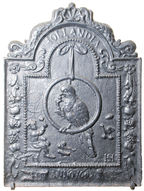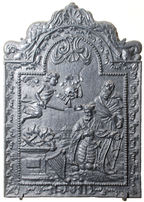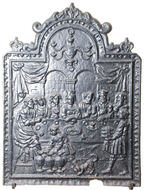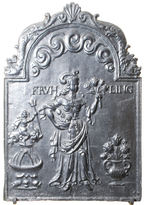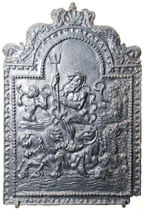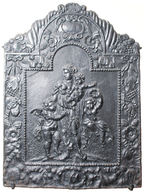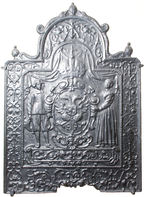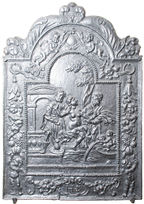-
526
Description: Arched rectangular central panel with bead on fillet edging; suspended from the top, by a ribbon, a ring with a popinjay, or parrot perched thereon, biting a twig in its right claw; below left is a seated child, and in the bottom corners the initial and monogram; around this panel is an arched rectangular border with fillet edging, at the top of which is the word, HOLLANDIA, between scrolls, with swags of fruit hung on ribbons suspended from roses down each side; at the bottom, a motto scroll bearing the inscription, ANNO 16 ...; on top, a central scallop shell between two dolphins.
Notes: A common design among firebacks produced in Germany for the Dutch market. Mitford collection, Petworth House.
Copies of this fireback are known.
Inscription: HOLLANDIA / H HS / ANNO 16 ...
- Decoration tags:
- 'Dutch' (shape)
- cavetto (edging)
- whole carved pattern
- pictorial
- allegorical
- monogram
- text
- animals
- humans
- objects
Manufactured: in the mid- to late-17th century in the Siegerland area of Germany.
Current location: Petworth House, Petworth, West Sussex, England.
Museum number: NT/PET/M/70 (part of the National Trust museum group)
- Attached to series:
- 'Dutch' Bird on perch firebacks
-
527
Description: Arched rectangular central panel with bead edging terminating at the top in two loops, gather drapery and a scallop shell; two figures to the right, both bearded, the one kneeling wears cavalry armour, a cloak and a crown, the other stands behind; to the left is a sacrificial pyre on which an ox carcass burns, and above an angel carrying a sword in his right hand and a skull in his left; around this is an arched rectangular border with fillet edging and a repeated leaf pattern; on top is a scallop shell between two dolphins.
Notes: The scene illustrates the visitation of the pestilence on Israel described in 2 Samuel 24, and the sacrifice of an oxen by King David; the skull borne by the angel represents the death of those struck down by the plague. A slightly different version has the face of David looking up at the angel (no. 424). Mitford collection, Petworth House.
Copies of this fireback are known.
Manufactured: in the mid- to late-17th century in the Siegerland area of Germany.
Current location: Petworth House, Petworth, West Sussex, England.
Museum number: NT/PET/M/81 (part of the National Trust museum group)
-
528
Description: Arched rectangular central panel with bead edging; pictorial scene of seven figures, the central one crowned, seated at a table laid with cups and dishes, with two other figures, one at the front, the other to the right, serving them; below are martial symbols (cannon, banners etc.); behind the figures are two archways with drapery at the side, and a chandelier above; arched rectangular border with fillet edging, and egg-and-dart moulding on top and sides; on top, a diamond within a cartouche, and the same on each shoulder of the plate; descending from the top, a serpent on each side.
Notes: The scene is of the marriage at Cana (John 2), a biblical story often portrayed on firebacks and stoveplates. Mitford collection, Petworth House.
- Decoration tags:
- 'Dutch' (shape)
- fillet (edging)
- whole carved pattern
- pictorial
- biblical
- architectural
- humans
Manufactured: in the mid- to late-17th century in the Siegerland area of Germany.
Current location: Petworth House, Petworth, West Sussex, England.
Museum number: NT/PET/M/82 (part of the National Trust museum group)
- Attached to series:
- 'Dutch' Miscellaneous Firebacks
- New Testament firebacks
-
531
Description: Arched rectangular central panel with cavetto-moulded edging; standing female figure holding a bunch of lowers in her left hand and a pot of flowers in her ight hand; to her left a ribbed, two-handled vase of tulips, to her right a fountain with a seated figure of Neptune/Poseidon holding a trident in the right hand; the words, Fruhling, split by the figure; above, clouds; on top a scallop shell between two descending sea serpents.
Notes: The iconic figure of Spring. Mitford collection, Petworth House.
Copies of this fireback are known.
Inscription: FRVH LING
- Decoration tags:
- 'Dutch' (shape)
- double fillet (edging)
- whole carved pattern
- pictorial
- allegorical
- text
- humans
- plants
- objects
Manufactured: in the mid- to late-17th century possibly in the Siegerland area of Germany.
Current location: Petworth House, Petworth, West Sussex, England.
Museum number: NT/PET/M/84 (part of the National Trust museum group)
- Attached to series:
- 'Dutch' Miscellaneous Firebacks
-
534
Description: Arched rectangular central panel with bead-on-fillet edging; pictorial scene of a seated couple (female to the left, male to the right) holding hands; behind, to the right, a sheep by a tree; arched rectangular border with fillet edging and probable foliate decoration; on top, scallop shell between two dolphins.
Notes: The symbolism of this scene is uncertain, but likely to be of an allegorical or iconological nature. Mitford collection, Petworth House.
Manufactured: in the mid- to late-17th century possibly in the Siegerland area of Germany.
Current location: Petworth House, Petworth, West Sussex, England.
Museum number: NT/PET/M/87 (part of the National Trust museum group)
- Attached to series:
- 'Dutch' Miscellaneous Firebacks
-
536
Description: Arched rectangular shaped central panel with fillet and bead edging, Neptune/Poseidon, holding a trident in his right hand, sitting in a scallop shell drawn by four mythical sea horses, behind are two mermaids blowing horns; arched rectangular shaped border with ovolo egg and dart edging; above, two symmetrical dolphins with a clam shell between.
Notes: Typical type of fireback produced in Germany by Dutch pattern makers; the central panel was made separately for insertion into different borders; this border is a relatively simple type. Mitford collection, Petworth House.
Copies of this fireback are known.
- Decoration tags:
- 'Dutch' (shape)
- ovolo, egg and dart (edging)
- whole carved pattern
- pictorial
- biblical
- animals
- humans
Manufactured: in the mid- to late-17th century in the Siegerland area of Germany.
Current location: Petworth House, Petworth, West Sussex, England.
Museum number: NT/PET/M/90 (part of the National Trust museum group)
- Attached to series:
- 'Dutch' Miscellaneous Firebacks
- 'Dutch' Dolphin series
-
540
Description: Arched rectangular central panel with bead edging; pictorial scene of Venus sitting in a couch, with two other females, swathed in drapery, a putto holding an oval mirror to her left; Arched rectangular border with fillet edging; central cartouche at top, with festoons of fruit, flowers and leaves suspended on each side from ribbons supported by rings; at the bottom, swirled ribbon around an oval compartment bearing the inscription; on top, a central cartouche from which descend a cornucopia on each side of the arch.
Notes: The design is a copy of 'The Toilet of Venus' by Simon Vouet (c.1640); the image has been reversed. The inscription indicates the style of border; other firebacks with the same inscription have the same border; similar inscriptions (e.g. L7C and L8G) indicate different borders. Von den Driesch (p.517) illustrates the same central image within an L8G border. Mitford collection, Petworth House.
Copies of this fireback are known.
Inscription: L6C
- Decoration tags:
- 'Dutch' (shape)
- fillet (edging)
- whole carved pattern
- pictorial
- mythological
- text
- humans
Manufactured: in the mid- to late-17th century in the Siegerland area of Germany.
Current location: Petworth House, Petworth, West Sussex, England.
Museum number: NT/PET/M/95 (part of the National Trust museum group)
- Attached to series:
- 'Dutch' LC/G series
-
541
Description: Arched rectangular central panel with bead edging; pictorial scene of a female holding a small child, with two putti, one on each next side of her; arched rectangular border with fillet edging; central cartouche at top, with festoons of fruit, flowers and leaves suspended on each side from ribbons supported by rings; at the bottom, swirled ribbon around an oval compartment bearing the inscription; on top, a central cartouche from which descend a cornucopia on each side of the arch.
Notes: The allegorical figure of Charity; the inscription indicates the style of border; other firebacks with the same inscription have the same border; similar inscriptions (e.g. L7C and L8G) indicate different borders. Mitford collection, Petworth House.
Copies of this fireback are known.
Inscription: L6C
- Decoration tags:
- 'Dutch' (shape)
- fillet (edging)
- whole carved pattern
- pictorial
- allegorical
- text
- humans
Manufactured: in the mid- to late-17th century in the Siegerland area of Germany.
Current location: Petworth House, Petworth, West Sussex, England.
Museum number: NT/PET/M/96 (part of the National Trust museum group)
- Attached to series:
- 'Dutch' LC/G series
-
542
Description: Arched rectangular central panel with canted top corners and bead-on-fillet edging; elaborate central cartouche containing the double-headed eagle of the Holy Roman Emperor supported by male and female figures standing on a compartment with fillet edging, containing scrolled foliage and a central fleur-d-lys; above the central cartouche, the imperial crown and swagged drapery; arched rectangular border with canted top corners and cavetto-moulded edging; symmetrical arrangement of traceried foliage; on top, central oval casket with a serpent descending on each side of the arch to a further similar casket on each shoulder of the plate.
Notes: A variation of the standard 'Dutch' style of fireback. Mitford collection, Petworth House.
Manufactured: in the mid- to late-17th century possibly in the Siegerland area of Germany.
Current location: Petworth House, Petworth, West Sussex, England.
Museum number: NT/PET/M/97 (part of the National Trust museum group)
- Attached to series:
- 'Dutch' Miscellaneous Firebacks
- Foreign armorial firebacks
-
543
Description: Arched rectangular centrel panel with bead on fillet edging; pictorial scene of a seated naked female with two clothed male figures behind; in front is a pool with a fountain to the right, and platform with a vase of flowers to the left; behind, an archway and a tree; arched rectangular border with fillet edging; at the top of the arch a cartouche from which are suspended two ribbons, each held by a putto, from which cascade flowers and fruit, each lower part hung from a ring; two putti are on each side, one climbing on the suspended ribbon, the other at its foot; at the bottom, a cartouche containing the monogram between two clusters of flowers each suspended on a ribbon tied to a scroll; on top, two descending cornucopiae.
Notes: The scene is of Susanna and the Elders from the biblical Apocrypha. Mitford collection, Petworth House.
Copies of this fireback are known.
Inscription: HIS
Manufactured: in the mid- to late-17th century in the Siegerland area of Germany.
Current location: Petworth House, Petworth, West Sussex, England.
Museum number: NT/PET/M/98 (part of the National Trust museum group)
